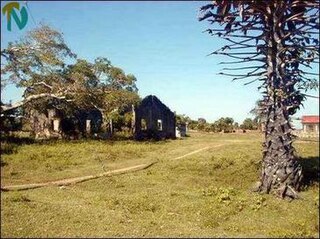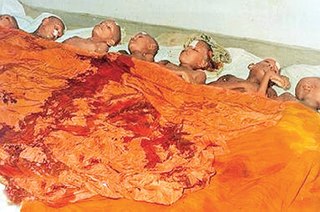
Kumarapuram massacre also known as 1996 Trincomalee massacre or 1996 Killiveddy massacre refers to the murder of 26 Sri Lankan Tamil civilians by the Sri Lankan Army soldiers on February 11, 1996. The victims included 13 women and 9 children below the age of 12. Further 28 civilians were severely injured as well. The event took place in a village called Kumarapuram, located in the eastern district of Trincomalee. It was a notable mass murder of civilians since the resumption of armed conflict between rebel forces and Sri Lankan armed forces since April 1995, as part of the Sri Lankan civil war. The then-government arrested a number of soldiers and home guards who allegedly carried out the massacre. A court case was started on 2004. On 27 July 2016 the court acquitted six former army Corporals who were accused over the massacre, after they were found not guilty.

The 1977 anti-Tamil pogrom in Sri Lanka followed the 1977 general elections in Sri Lanka where the Sri Lankan Tamil nationalistic Tamil United Liberation Front won a plurality of minority Sri Lankan Tamil votes in which it stood for secession. An official government estimate put the death toll at 125, whereas other sources estimate that around 300 Tamils were killed by Sinhalese mobs. Human rights groups, such as the UTHR-J, accused the newly elected UNP-led government of orchestrating the violence. While the large majority of victims were Tamils, Sinhalese civilians in the Northern Province and Eastern Province were also attacked by Tamil mobs following the initial violence against Tamil civilians.
The Kent and Dollar Farm massacres were the first massacres of Sinhalese civilians carried out by the LTTE during the Sri Lankan Civil War. The massacres took place on 30 November 1984, in two tiny farming villages in the Mullaitivu district in north-eastern Sri Lanka. The Sri Lankan government labeled this as an attack on civilians by the LTTE.
The Palliyagodella massacre was carried out by the Liberation Tigers of Tamil Eelam (LTTE) against the mostly Muslim population of the Palliyagodella village located on border region of the northern part of Sri Lanka that were controlled by the Tigers at the time. This was the largest massacre of Muslim civilians by the LTTE to date. Village eyewitnesses claim that some 285 men, women and children, around a third of the population, were killed by a 1,000 strong force of the Tamil Tigers; however, the Sri Lankan government states that the LTTE massacred 166 to 171. All but 40 of the victims of the Palliyathidal massacre were Muslim; the rest were Sinhalese.
The Mylanthanai massacre happened on August 9, 1992 when 35 minority Sri Lankan Tamils, including 14 children, at Mylanthanai in Batticaloa District in Sri Lanka, were killed.
Eelam War I is the name given to the initial phase of the armed conflict between the government of Sri Lanka and the LTTE.

Eelam War II is the name given to the second phase of armed conflict between Sri Lankan military and the separatist Liberation Tigers of Tamil Eelam. The war started after the failure of peace talks between the Premadasa government and the LTTE. This phase of the war was initiated by the LTTE who massacred almost 600 Sinhalese and Muslim police personnel after they were ordered by the Premadasa government to surrender to the LTTE. The truce was broken on June 10, 1990 when the LTTE in October expelled all the 28,000 Muslims residing in Jaffna.

The Aranthalawa massacre was the massacre of 33 Buddhist monks, most of them young novice monks, and four civilians by cadres of the Liberation Tigers of Tamil Eelam organization on June 2, 1987, close to the village of Aranthalawa, in the Ampara District of Eastern Sri Lanka. The massacre is among the most notorious and devastating atrocities committed by the LTTE during the history of the Sri Lankan Civil War, and continues to be commemorated 35 years on.
The Kattankudy Mosque Massacre was the killing of over 147 Muslim men and boys on 3 August, 1990. Around 30 armed Tamil militants raided two mosques in Kattankudy where over 300 people were prostrating in Isha prayers. The Sri Lankan government, survivors, and observers accuse the Liberation Tigers of Tamil Eelam (LTTE) of committing the crime. The LTTE denied involvement and never retracted the denial.

Vaddakkandal massacre was a massacre of Tamil civilians in the Tamil village of Vaddakkandal in Mannar district of the Northern Province, Sri Lanka. At least 52 residents of the village who were mostly agricultural laborers working in their fields were brutally attacked and killed by the Sri Lankan military forces. More than 40 people were left seriously injured by the attack. Several of those killed included women, elderly, and even infants. There had been no investigations into the massacre and no member of the Sri Lankan Army has been brought to justice for the killings yet.

The 1985 Trincomalee massacres refers to a series of mass murder of Tamil civilians by the Sri Lankan military and Sinhalese home guards in Trincomalee District, Sri Lanka. In a succession of events that spanned over two months, hundreds of Tamil civilians were massacred and thousands were driven out by the Sri Lankan military and Sinhalese mobs in order to colonize the area. Almost every Tamil settlement in the district was destroyed during this well-orchestrated campaign to drive out the local Tamil population. Several Tamil women were also raped. In September 1985, the entire Tamil population of Trincomalee town was displaced to forests and refugee camps in an attack that wiped out the town, including the destruction of 12 temples and a mosque. Since August 16, over 50,000 Tamils who were forced to flee the town ended up in refugee camps in the Jaffna and Batticaloa districts.
The following lists events that happened during 1992 in Sri Lanka.
The Aluth Oya massacre was the massacre of 127 Sinhalese civilians, including children and women, by the cadres of Liberation Tigers of Tamil Eelam organization on April 17, 1987, near the village of Aluth Oya, on the Habarana Trincomalee road in North Central Province of Sri Lanka. This massacre is considered one of the most notorious and devastating atrocities committed by the LTTE during the history of the Sri Lankan Civil War.
The 1989 Kandy massacre was a series of retaliatory attacks on the villages of Menikhinna, Arangala, Mahawatta, and Kundasale in the Kandy District of Central Province, Sri Lanka during the 1987-89 JVP Insurrection. While the massacre was officially attributed to the vigilante group Eagles of the Central Hills, other reports and eyewitness accounts claim that it was a joint operation conducted by the army and police. It was one of the largest single incidents reported to Amnesty International during the JVP Insurrection.
Sexual violence against Tamils in Sri Lanka has occurred repeatedly during the island's long ethnic conflict. The first instances of rape of Tamil women by Sinhalese mobs were documented during the 1958 anti-Tamil pogrom. This continued in the 1960s with the deployment of the Sri Lankan Army in Jaffna, who were reported to have molested and occasionally raped Tamil women.
The Veeramunai massacres refers to the mass killing and disappearances of over 250 Tamil civilians by Sri Lankan security forces and Muslim home guards in 1990.





